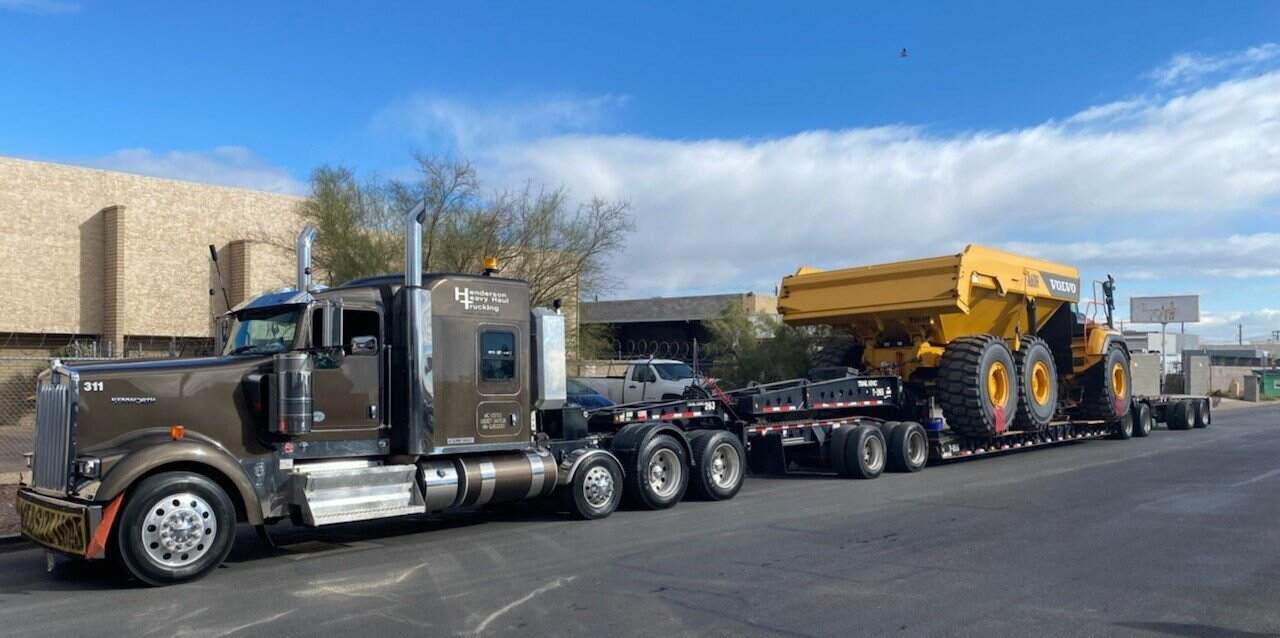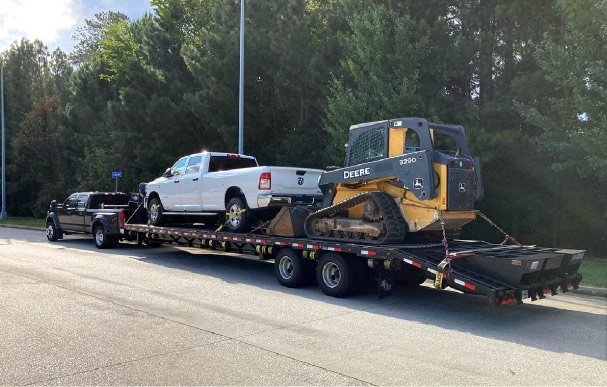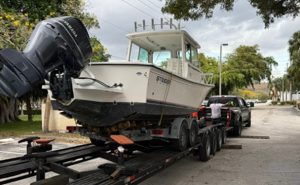 Book online
Book online
 Pickup
Pickup
 Shipping
Shipping
 Delivery
Delivery
Heavy Equipment on the trailer
The following outlines essential risk guidelines for the transfer of heavy equipment. It is imperative to understand the safety protocols and recommendations for the loading and transportation of heavy machinery.
How to Load and Haul Your Heavy Equipment or Machinery on Trailer
Moving heavy cargo from place to place isn’t an easy job. Luckily, there are tons of ways to ensure you’re correctly transporting your extreme loads. Taking steps to properly prepare your truck for hauling and staying up-to-date on local, state, and federal regulations can ensure you load your materials the right way. Following safety guidelines is especially a must when handling large cargo. When traveling long distances or even just down the street, you can avoid fatal car accidents. Here are some key tips for how to safely load and transport your heavy equipment.

How to Load Heavy Equipment on Your Trailer
-
Determine the Weight and Dimensions of Equipment
Every trucker should know the dimensions and weight of their heavy load. Knowing the height, width, length, and weight of your extreme cargo is essential to safe transport. Hauling Most important, DOT regulations have specific procedures and securement methods truckers should follow when transporting heavy equipment.
-
When to Use an Oversize Permit
Some states even require truckers to have an oversized load permit when hauling extreme machinery. The rules may vary per state, though. For instance, if you’re transporting a dozer or any construction equipment 12ft wide in the state of Ohio, you will need a permit. A trucker might even need a police escort to warn other drivers to keep their distance. Unfortunately, hauling oversized materials can be expensive for some companies. To avoid high prices, some companies will ask truckers to transport their heavy equipment, tools and attachments separately. This way, they can avoid the high transportation expenses.
-
Choose the Right Trailer Size & Capacity
Additionally, you should choose a trailer that can handle the weight of your cargo. It also must be able to accommodate the height of your load. There’s been too many times truckers have crashed their loads into bridges because they didn’t have enough clearance. Most interstates require a minimum clearance height of 14ft, while others suggest 16ft. A step-deck or lowboy trailer usually meets these FHWA height requirements.
-
Inspect Your Trailer
A truck driver should also do a full inspection of their truck and trailer to prepare it for the big haul. How exactly do you tie down your heavy equipment on a trailer? Make sure your truck and trailer support your cargo’s extreme weight. The tire pressure, the lights, and the brakes of your truck must also be in working order. Most importantly, check that all your securement points are intact. Four tie-down points are required for most cargo, but extreme loads require 5 or more points. The WLL of all your tie-downs must be half of your cargo’s weight as well. This way, everything remains balanced over your trailer.
-
Clear the Loading Area
Another way to make sure you’re loading your cargo effectively is by picking a remote spot to do so. It seems trivial, but you want an uninhabited area that will allow you to set up a ramp to load your materials on. You can’t do it during rush hour traffic. Otherwise, you risk making tons of mistakes because you’re in such a hurry to get off the road. The area of your choosing must also have level and sturdy grounding to handle the weight of your trailer when fully loaded. You wouldn’t want any sinkage to happen.
-
Use Trailer Ramps to Load and Secure Your Equipment
While loading and unloading your heavy equipment, you’ll want to take things slow. Drive your heavy equipment slowly up the trailer ramp and onto the truck’s trailer. Once it’s on the trailer, shift most of the weight of the machine towards the front. That way, you can avoid running into the issue of your truck fishtailing during the transport.
Transport Heavy Equipment Using Tie-Downs
Consider the DOT regulations
There’s a lot more to trucking than just delivering goods. You have to make sure you’re staying safe on the road as well. Regularly checking state laws and regulations on how to transport heavy machinery will ensure you’re staying safe on the road. One of the best ways to secure your extreme cargo is by using various tie-downs.

Use Tie Down Equipment
Tie-down equipment is required to secure heavy cargo, construction machinery, and other items for transportation or storage in order to ensure safety and avoid damage. Here are some examples of standard tie-down equipment and how to utilize it.
Use Chains & Binders
One of the best ways to secure your extreme cargo is to use chains and binder hooks. During
transportation, you don’t want your equipment to shift or bounce around on your trailer. Using transport chains will ensure there’s no movement. However, make sure that your chains and the hook binder grades work in harmony to ensure a secure hold. Cross-reference your chain’s grade with the boomer handle. As previously mentioned, your tie-down equipment’s WLL must add up to 50% of the weight of your cargo. The chain’s grade can’t go past the WLL of the boomer’s limit, either.
Tension All Your Tie-Downs
Tensioning your ratchet straps and chains will ensure your cargo stays locked in place on your truck. DOT regulations also have rules to ensure that you use precise tensioning for your materials, especially in the case of heavy equipment. For instance, truckers must have their chains all fastened vertically, not horizontally, to keep their cargo stabilized.
Use Edge Protection
Corner and edge protectors are also a must-have for extreme cargo. As the name suggests, they keep your load safe from harm. Not only do they keep your extreme cargo safe but edge protectors also protect your ratchet straps from wear and tear. Some pieces of machinery may have sharp edges that could rip right through your straps. Corner Protectors will help your straps last for years to come.
Use an Oversized Load Sign & Lights
Any cargo that exceeds the length of your flatbed truck is required by law to have some signage. Oversized load signs, Beacon Lights, and flags help you keep the roads safe during extreme transport. Not to mention, they warn other drivers that you’re hauling an abnormally large load and that they should keep their distance.
Secure the Wheels with Chocks
Another piece of tie-down equipment that’ll help you stay compliant with DOT regulations is a wheelchock. During loading and unloading procedures, truckers use these wedges to help keep their trucks from moving. Any movement at all could lead to a loss of materials and even a fatal
car accident.
Secure Your Equipment’s Components
While you want your extreme cargo secure, your tie-downs must be stable as well. Make sure all of your hooks, work tools, spare tires, and tailgate lights are functioning. Any levels or gauges must be wrapped up to prevent damage on the road. In the end, your tie-down equipment must be secure to protect your cargo.
Verify Driver Visibility
A truck driver should always be aware of their surroundings as well. That also includes the arrangement of the cargo over their truck’s trailer. Your heavy cargo should be positioned in such a way that you have access to your truck’s integral parts during breakdowns or repair work. Not to mention, it takes the worry out of receiving a hefty fine from the police.
Hit the Road
Now that you have everything secured over your truck’s trailer, you’re ready to hit the open road. However, during breaks and gas stops, check all your tie-downs and cargo. Things tend to move during long journeys and it’s always a good idea to have regular check-ups. If you notice slack in your straps and chains, add more tension. That way, you can rest assured knowing that
your equipment is secure.
Hauling Heavy Machinery Can Be Made Easy
After reading this blog, the long drive ahead of you doesn’t look so daunting anymore. You may have to haul extremely large and heavy cargo, but it can be done if you follow these simple tips. At the end of the day, you want to learn how to haul heavy machinery as efficiently and safely as possible.
We are experts in heavy hauling across the nation
- Alabama
- Alaska
- Arizona
- Arkansas
- California
- Colorado
- Connecticut
- Delaware
- Florida
- Georgia
- Hawaii
- Idaho
- Illinois
- Indiana
- Iowa
- Kansas




